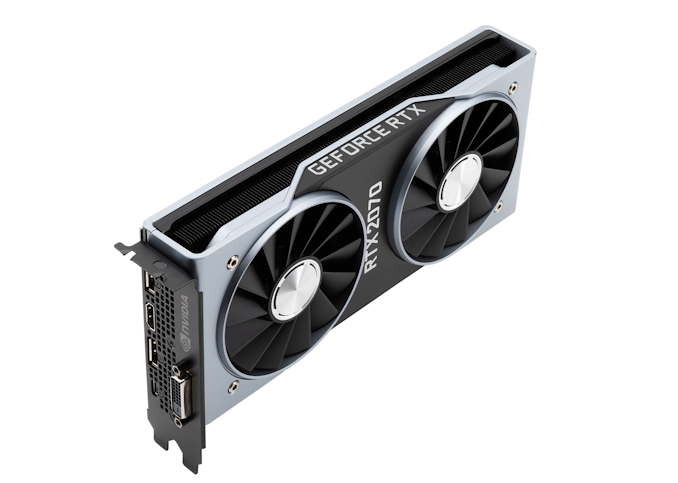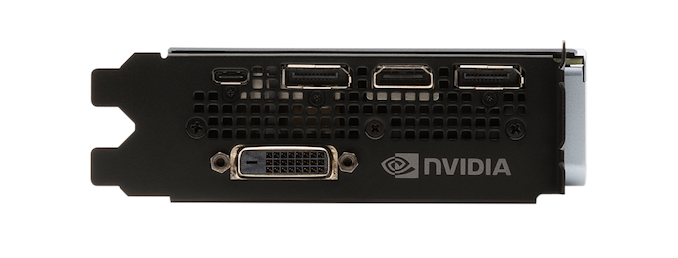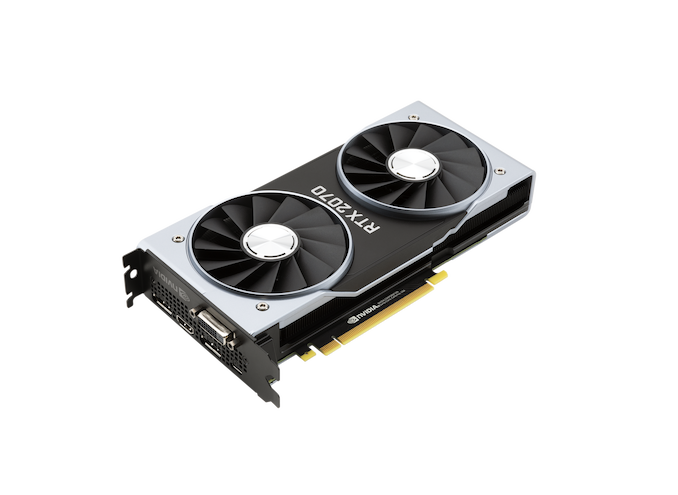The NVIDIA GeForce RTX 2070 Founders Edition Review: Mid-Range Turing, High-End Price
by Nate Oh on October 16, 2018 9:00 AM ESTMeet The GeForce RTX 2070 Founders Edition Card
Touching quickly on the card itself, there's little we haven't already seen with the RTX 2080 Ti and 2080 Founders Editions. The biggest change is, of course, a new open air cooler design. Along with the Founders Edition specification changes of +10W TDP and +90 MHz boost clockspeed, the cards might be considered 'reference' in that they remain a first-party video card sold direct by NVIDIA, but strictly-speaking they are not because they no longer carry reference specifications.
Wrapped in the flattened industrial design introduced by the other RTX cards, the RTX 2070 Founders Edition looks essentially the same, save a few exceptions. The single 8-pin power connector is at the front of the card, while the NVLink SLI connectors are absent as the RTX 2070 does not support SLI. Internally, the dual 13-blade fans accompany a vapor chamber, while a 6-phase system provides the power for the 185W TDP RTX 2070 Founders Edition.
So while the single 8-pin configuration, suitable for up to 225W total draw, has remained the same from the GTX 1070, the TDP has not. The RTX 2070 Founders Edition brings 185W, with reference specification at 175W, compared to the 150W GTX 1070 and 145W GTX 970, following the trend of the 2080 Ti and 2080 pushing up the watts.
As for I/O, there is one difference between the 2070 and its older siblings. The RTX 2070 Founders Edition drops the isolated DisplayPort for a DVI port, matching the GTX 1070's outputs. This is in addition to DisplayPort 1.4 and DSC support, the latter of which is part of the DP1.4 spec, as well as the VR-centric USB-C VirtualLink port, which also carries an associated 30W not included in the overall TDP. While the past few years have seen DVI excised from the top-end cards, it's more of a matter of practicality for mid-range cards (inasmuch as $500 is a midrange price) that are often paired with budget DVI monitors, particularly as a drop-in upgrade for an aging video card.
As mentioned in the RTX 2080 Ti and 2080 launch article, something to note is the potential impact on OEM sales with this reference design change. The RTX 2070 also arrives as an open air design and so can no longer guarantee self-cooling independent of chassis airflow. In addition to the price and lower volume nature of these GPU parts, these aspects make the RTX reference cards less suitable for large OEMs.














121 Comments
View All Comments
webdoctors - Friday, October 19, 2018 - link
You should shop around. I bought a new EVGA 1070TI from Amazon last weekend for ~$270.The regular 1070 is also that price now on Amazon website.
The 1070TI definitely seems the sweet spot for upgrading right now...
philehidiot - Tuesday, October 16, 2018 - link
Have to agree here. I'd like to see the 1070Ti for completeness but Anandtech may not have the card to hand (you simply can't always keep stock of / put your hands on every card you want), might be planning on adding it later or just thought it'd be easy enough to extrapolate where it will fall. As for value for money, I did a massive table (in pen for some reason) which calculated aggregate benchmarks for a load of cards (1080Ti, 1080, 1070Ti, 1070, Vega 64) that I was interested in and then calculated a performance per Pound (UK here) for each one. Aside from the 1080Ti (which was far better value in terms of performance per Pound), the rest had practically identical value rankings aside from the AMD card which was slightly lower. I actually ended up buying a Vega 64 as the price briefly dropped by £110 just before Turing was released which made it an absolute bargain and, seeing the performance here, I'm relatively delighted that for once the GPU market has not screwed me over. I'm guessing the prices dropped as people were expecting Turing to be amazing and now they're back up as it's just pretty meh all over and very overpriced. My old card went for £100 (I don't normally sell them, but give them away to a friend) and so my cost to upgrade was ~£300 which I'm very happy with given that I would never EVER consider spending 2080 / 2080Ti money on a GPU. The worst part for Nvidia is that I am their target market - I'm a gamer who spends a lot of money on his PC to play the latest games at decent quality settings and I'm also a professional who isn't exactly poorly off. Could I afford a 2080Ti? Easily. Would I EVER buy one? No. The price is insulting and so is the marketing. I'd have never have considered AMD before they released all that insulting marketing rubbish. They gave AMD a sale.Spunjji - Wednesday, October 17, 2018 - link
I know at least one other person with the exact same story. It's irritating for folks like us, but as long as the market continues to swallow it they won't miss our sales!hansmuff - Tuesday, October 16, 2018 - link
A 1070 Ti is way too close to the 2070 in perf, why bother at this point when you don't know if the new features bring anything to the table with the 2070?A lot of people have 1070's, non-Ti, and have more reason to wonder if this a significant enough upgrade. I think Anandtech did the right thing here.
JoeyJoJo123 - Tuesday, October 16, 2018 - link
Nah. 1070Ti is as low as ~$400. 1080 is as low as ~$440.http://gpu.userbenchmark.com/Compare/Nvidia-GTX-10...
Game performance differentials range from 6% to as much as 22%, but i'd say for 10% more on the price, you get a tiny bit more than 10% of the performance uptick. Hence, 1080 is a better overall value in terms of price/performance to 1070 Ti.
Death666Angel - Tuesday, October 16, 2018 - link
Not according to Techpowerup and German prices. The cheapest 1070ti is 430€, the cheapest 1080 is 480€. The relative performance towards a 2080Ti is 62%/55%/50% for the 1070Ti in 1080p/1440p/2160p and 66%/58%/52% for the 1080 in the same resolutions. That means the 1080 delivers only 95%/94%/93% of the performance/€ compared to the 1070Ti. Things are so close though as to warrant a real inspection when seeing a deal for one card or another.Vayra - Monday, October 22, 2018 - link
While true, once overclocked, the 1080 can stretch its legs a bit more due to the faster GDDR5X, making the lead a bit larger, and its additional shaders also benefit a bit more from a 'similar' clock to a 1070ti. They're almost a perfect match if you consider perf/dollar, and in that case the 1080 is and was always the better choice, because higher absolute performance should usually result in a worse perf/dollar number.Marlin1975 - Tuesday, October 16, 2018 - link
I'll take a $329 RTX2080. Comparison chart is off.Performance is not bad, but the price is. Until the price comes down the 1080 seems like a much better buy, esp with rebates on some now.
Koenig168 - Tuesday, October 16, 2018 - link
Paying for RTX which we cannot use ATM and not sure we want, bearing in mind the performance hit.Antoine. - Tuesday, October 16, 2018 - link
Why do you compare in your final words the RTX2070 to the GTX1070? Just because they have the same marketing endname does not mean it's in the best interest of your readers to compare these two.The only relevant guide here is the pricing of course! RTX2070 have the same pricetag as GTX1080TI. Comparing it to GTX1070TI is a stretch but why not. But the 1070?! a 400-dollar card?